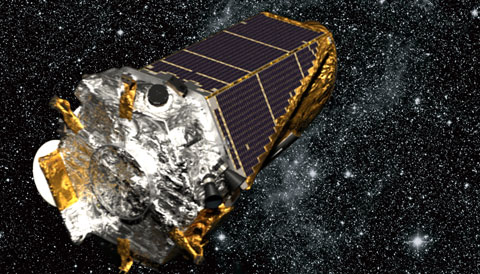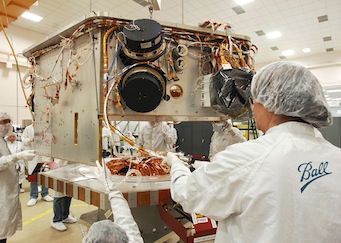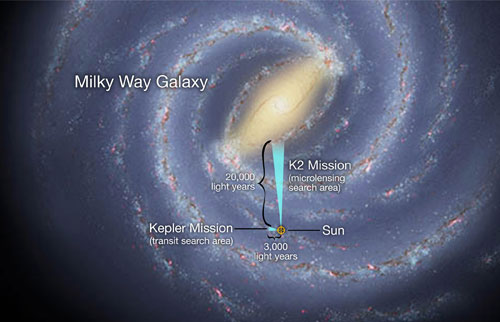The Kepler team unexpectedly found the planet-hunting spacecraft in emergency mode on April 7th, but with the spacecraft recovered, hopes are high that its newest search, this time for rogue planets, is still on.
| Update (April 22, 2016): Aaand we're back! Kepler has aced its health exams and officially resumed Campaign 9. Read more details in today's Mission Manager Update. |
| Update (April 15, 2016): So far, so good: Kepler has remained stable as engineers continue to check the health of the spacecraft and its instruments. Read the latest NASA update for more details. |

NASA
On April 4th, the Kepler team checked in on their planet-hunting spacecraft. The team was ramping up for Campaign 9, a special observing project that would flip the spacecraft around to gaze past Earth at the galactic center and search for rogue planets floating through interplanetary space. The spacecraft was in good health that day and operating as normal.
But when the team next contacted Kepler on April 7th, they found Kepler in an emergency mode. Something had gone wrong 14 hours before any maneuvers had even started. The emergency mode status was a concern, as it drives the spacecraft to burn excess fuel to stay turned toward Earth for communication.
After a long weekend, the Kepler team is now reporting that the spacecraft has been recovered and is now operating in its lowest fuel-burn mode. Engineers are currently downloading data, and over the next week will be testing Kepler's systems to both check its overall health and determine what caused the system shutdown.
The team has also canceled the spacecraft emergency that was declared in order to give the spacecraft priority access to the Deep Space Network that NASA uses to communicate with all solar system probes.
Kepler: The Space Cat with Nine Lives
Kepler has already had a distinguished career. Trailing behind Earth in its orbit, the spacecraft stared at a small patch of sky for four long years. It was looking for planets transiting across the face of stars, and it found them: about 4,700 candidate planets, and more than 1,000 confirmed planets.

Ball Aerospace
But even as its discoveries were homing in on the mission’s goal (finding an Earth-size planet in an Earth-like orbit around a Sun-like star), the spacecraft lost first one of its reaction wheels (in July 2012) then another (May 2013). Each time, the failures shunted the spacecraft into "safe mode." (Last week's emergency mode was the first in Kepler's 7-year history.) With only two reaction wheels working to orient the spacecraft with the high precision needed for the transit observations, the Kepler team had to call it: the original mission was over.
But Kepler was far from dead in the water. The telescope still had its wide field of view and the ability to measure the brightness of tens of thousands of stars in its field of view with a high level of precision. Astronomers were determined to make use of those valuable facilities: though “Kepler Prime” was over, now it was time for “K2.”
By balancing the radiation pressure felt from the Sun’s light with power from the spacecraft’s thrusters, along with the two remaining reaction wheels, the telescope would have a second life observing various targets along the ecliptic plane. Already, K2 has found 270 planet candidates and 30 confirmed planets. More than that, it has observed open star clusters, measured starquakes and other stellar rumblings, and searched for supernovae.
And the next item on the spacecraft’s bucket list is Campaign 9.
Campaign 9: The Search for Rogue Planets
K2’s time on the sky is organized into roughly 80-day observing periods of different pieces of sky, each campaign with a different science focus. The 9th in the series is a long look at the galactic center, which should have started April 7th and will go through July 1st. (July 1st marks the end of Kepler's view of the galactic center, so despite the emergency mode, observations can't be extended to make up for lost time.)

NASA Ames / JPL-Caltech / T. Pyle
As interesting as our galaxy’s busy downtown may be, the stars themselves aren’t the campaign’s main focus. Rather, the Kepler team is looking for the short, sharp brightening of a faraway star that would indicate a body was moving in front of it. A foreground body’s gravity acts as a lens, bending the background star’s light around to magnify it, a phenomenon known as gravitational lensing.
Some of those foreground bodies will be stars, and some may even be stars with planets. But some subtle gleams could come from much smaller bodies: free-floating planets. Kepler’s telescope has the precision to pick out these changes in brightness among the crowded field of stars. The team expected to spot five or ten rogue planets during Campaign 9.
But the spacecraft needs Earth’s help. On its own, Kepler can measure the light curve of a brightening star, but information from just one observer is limited. To pick apart the bodies’ masses and other details, Kepler needs an observing partner.

NASA Ames / W. Stenzel and JPL-Caltech / R. Hurt
So although Kepler generally trails Earth facing the other way for its observations, Campaign 9 requires Kepler to flip around and gaze past Earth instead. “This is the first time that Kepler would be turned around like this for a campaign,” says Rachel Street (Las Cumbres Observatory Global Telescope Network). The team has ruled out both the flip maneuvers and the reaction wheels as the cause of the emergency.
Once it has flipped around, Kepler and a network of Earthbound observers will watch the same part of the sky at the same time, comparing notes. And in the last week or two of the campaign, the Spitzer Space Telescope would even get in on the game — it trails Earth at an even farther distance than Kepler does.
There’s an opportunity here for amateurs too. “Traditionally, citizen scientists have long played a very active role in observing microlensing events,” Street notes. “I would like to encourage them to continue.”
Street helped build the ExoFOP website that lists K2 microlensing targets already being observed (groundbased observations started in February) — amateurs can register on the website to share data in real-time. “These events are happening right now, so we're using this list to choose which targets we observe, and citizen scientists are very welcome to join us!”
Groundbased observations, amateur and professional alike, will continue even as the Kepler team continues the spacecraft's health check throughout the week.
 0
0









Comments
You must be logged in to post a comment.